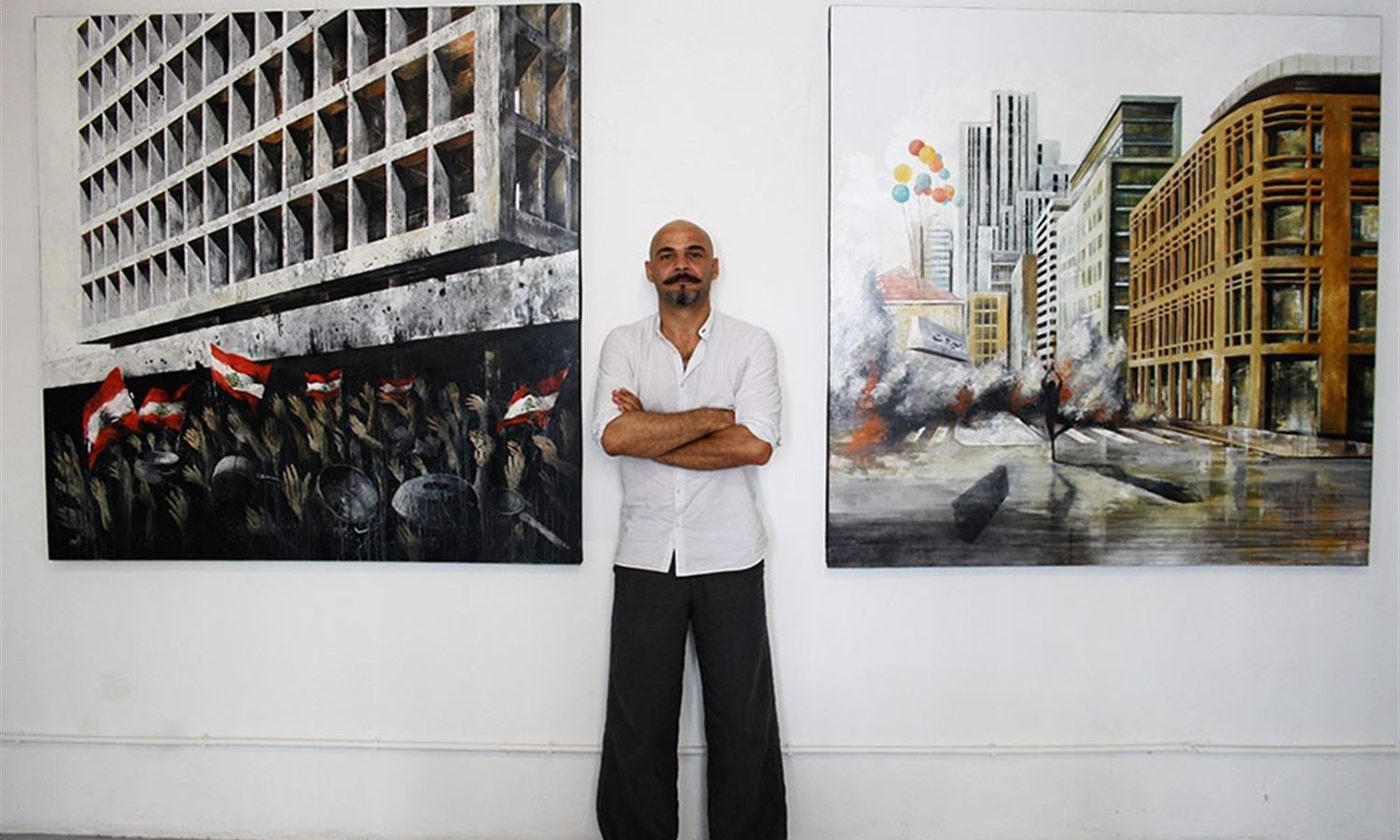Mohamed Al-Mufti (born in Damascus 1976) is an artist, architect, musician and professor at the University of Alba. He moved to Versailles, France in 1994 to pursue his studies in architecture, where he graduated, and he opened his own office and at the same time he worked on his own paintings.
Mohamed Al-Mufti held his first exhibition in France in 2003.
Until 2011, his works were experimental art until the crisis in Syria began, touching reality through scenes of poverty, assassinations, and wars. Then he saw it necessary to document these events and all stages objectively, away from his personal opinion or political inclinations.
In the winter of 2020 he held an exhibition in Paris titled Anamnèse where he documented the neighborhoods and symbols of his motherland, Syria.
Today he resides in Lebanon, and his fourth exhibition was opened here in Gallery 392 Rmeil 393 (Gemayzeh / Beirut) entitled "And then stillness", which includes 21 paintings and 10 sketches, and it has served as a visual archive for Beirut since the beginning of its revolution on October 17, 2019 to the present day.
In Modern Arabesque, we visited the exhibition and interviewed the artist Mohamedd Al-Mufti, here are the details of the interview:
First of all, "Why did you choose Lebanon as a theme for this exhibition?
I consider Lebanon as a "bouée de sauvetage", a somehow quiet country until the problems of the dollar, poverty and hunger began, and people were discharged from their work, so it was necessary to shed light on these problems, so I drew the first painting in June 2019.
Consequently, the events were very fast in Lebanon, " As soon as I finished a painting, another event was starting "
As a Syrian citizen residing in Lebanon, I developed a very strong bond with this country ... love and hate at the same time, and it is my duty as a foreigner to put my own mark, as an external view of events that happen away from any party or affiliation.
What was the reaction of the Lebanese, especially since you are a Syrian citizen, embodying the Lebanese situation?
I have been staying in Lebanon for 8 years, some of the people have forgotten that I carry a Syrian nationality, especially because I am a professor at the University of Alba and I speak the French language. As for those close to me and who know me personally, they were glad and found it open minded. Few others, commented in a negative way.
How was the exhibition turnout? Like your expectations?
No, much better.
If we didn’t have the difficult financial situation and closure due to the pandemic of the Corona virus and the fear of people from the gatherings, the exhibition would have appealed with more people.
Of all these paintings, which one is closest to you?
The Mediterranean Slay Bank painting.
We notice that abstract sketches are very similar to paintings, when did you draw them?
I start my work with quick abstract sketches of an idea, and with each painting I draw 30 to 40 sketches with Indian ink. Which some of them are displayed, by the way, airport sketch is my favorite.
Through your architectural paintings, we have seen the amount of engineering consistency, rigor and organization. Does this reflect your daily lifestyle?
I don't know (laughing)
I think that what you usually see on a painting is the opposite of the artist, as if the artist is trying to embody in the painting what is not in his character.
What about these three faces?
it’s “Asfooriya"... every face expresses the psychological state that the Lebanese people have reached: the first is mentally impaired, the second is depressed and the third is afraid.
Some have been surprise of the existence of these painting within the architectural density, but this is not an architectural exhibition, and I like this contrast. It is a harmony between flesh and stone.
What about the political and economic dimension that you embodied in the democracy piece?
I drew this painting before the Corona pandemic, where the Speaker of Parliament sits alone in his chair with a mask on his face, a symbol of the separation between the people and power. Then the Corona pandemic started, and all the people put on their masks, which led to social and political separation.
In the end of our dialogue what would you like to say as a message?
What matters most to me is the strength of the work than its aesthetics, so it is necessary for artists and admirers to stop looking at art as an aesthetic only. We now live in an ugly era, from moral, to political, to economic and environmental. So it’s essential for the art to be ugly but theoretically beautiful.
The exhibition "And then stillness" continues until August 7, but an appointment must be scheduled in advance. Therefore, we encourage you not to miss this opportunity. Once you enter the exhibition, you will see a brief overview of the reality that we have lived and are still living ... Each painting tells thousand stories, it reflects how we moved from noise to silence, and from popular gatherings to isolation.
It’s fantastic how Al-Mufti managed in a short period of time, to turn these observations into paintings that reflects strength and perseverance, non-surrender and sacrifice in order to obtain a better homeland.
Al-Mufti also added that this exhibition is not the end of this serie, and that he is preparing for a second part of it.
From the Modern Arabesque team, we thank Mohamed Al-Mufti for his time and we will be looking forward for his future work.
Mabelle Milane
Modern Arabesque

.jpg)
.jpg)
.jpg)
.jpg)
.jpg)
.jpg)